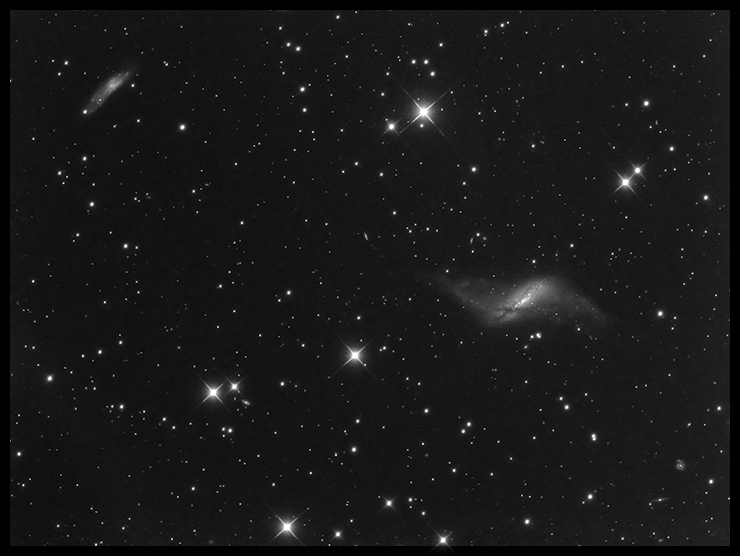11/29/2013. Black Friday. Well, not exactlly "black" but the sky was a darker shade of grey than usual, so I put the 10-inch RC back on the mount and set up the CCD camera in order to revisit a subject I last imaged almost two years ago (January 2012): the polar ring galaxy NGC 660 in Pisces.

NGC 660
36x300s L (3 hours), darks and flats applied, -30°C
AT10RC @ F4.8, ST2000XM

Same, but most of the image processing
was done using PixInsight (maybe just a little too much).
Note cleaner stars and improved detail in the "shadows."
Is the oddly bent galaxy at upper left the interacting partner for NGC 660? Had no idea that it might be until checking these photos. Guide shows them at similar distances. 14th magnitude asteroid 847 Agnia drew a couple of hyphens at upper right; the break in its trail documents my brief attempt to take some RGB data. Nothing much worth showing off came of that. The Robofocus bits would not power up this evening, so this one was manually focused. I used Vega and a Brahtinov mask at the start of the evening and refined focus later by slewing to Hamal and using its diffraction spikes to zero in on a good position. That worked out well, which suggests that I could simplify my life a little and regard the tangle of focusing electronics as optional. Just before closing up for the night, I shot a dozen Christmas tree flats. 15 seconds through the double diffuser worked well. 30 might have worked better.
12/01/2013. The sky was clearer than I expected, so I added some data. I used the flat from night before last and new darks from last night; I also shot some new darks at -20°C because of frosting on the chip. I changed the dessicant (desiccant?) pack late in the afternoon, so this problem should go away soon. At 5h50m, the H-II regions along the polar ring begin to shine. Twice this exposure and some good color data will be interesting especially if sweetened with a few hours of H-a:

NGC 660
70x300s L (5h50m), -30°C & -20°C
AT10RC @ F4.8, ST2000XM
Except where noted, deep-sky photos are made with an SBIG ST2000XM CCD behind a 10-inch Astro-Tech Ritchey-Chretien carried on an Astro-Physics Mach1GTO. The CCD is equipped with Baader LRGB and 7nm H-a filters. The internal guide chip of the CCD most often keeps the OTA pointed in the right direction (I'll let you know when a Meade DSI and a separate OAG or guidescope takes its place). Camera control and guiding are handled by Maxim DL 5.12. The stock focuser on the AT10RC has been augmented with Robofocus 3.0.9 using adapters turned on the lathe downstairs. Maxim performs image calibration, alignment, and stacking; Photoshop CS4 and FocusMagic 3.0.2 take it from there. Gradient Xterminator by Russell Croman and Astronomy Tools by Noel Carboni see their share of work, too. Beginning in May 2013, PixInsight has taken over some of the heavy lifting for transfer function modification and deconvolution.
:: top ::